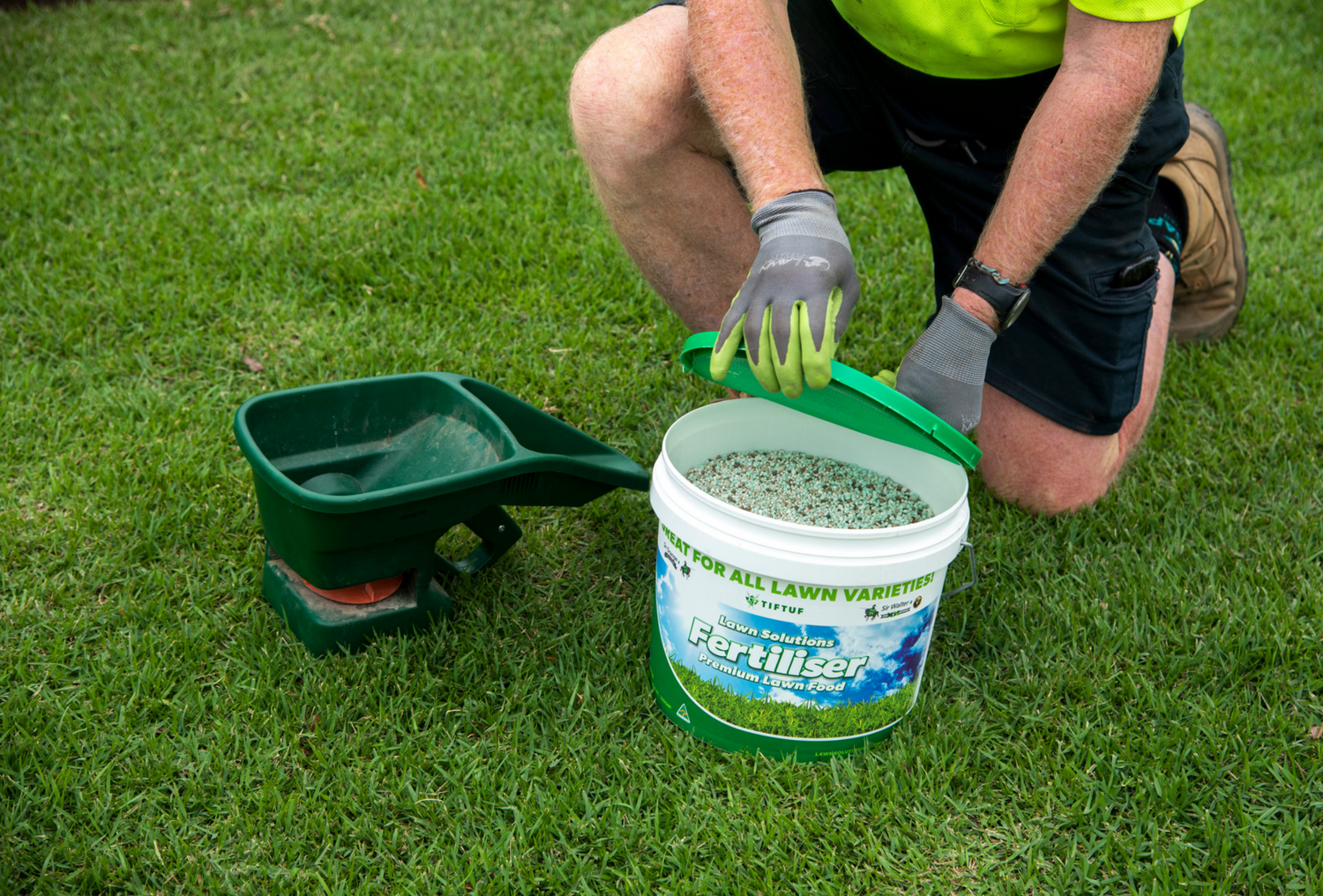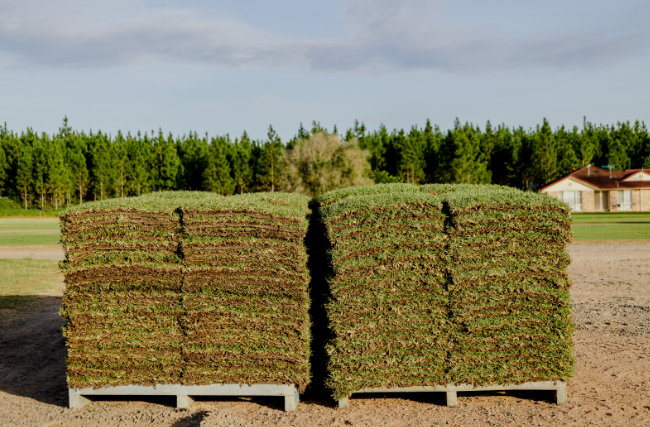Ever wonder why your neighbour's lawn looks like it belongs on a golf course while yours resembles a patchy mess? The answer isn't expensive, and isn't complicated.
It's lawn fertiliser.
When it comes to your lawn, the more you put in, the more you get out of it. So while you're puzzling over their perfect green grass, they're treating their lawn exactly like the living organism it is.
So, what exactly goes into these fertilisers that makes such a dramatic difference?
Understanding Fertiliser Fundamentals
Fertiliser feeds your lawn. Since turf is a living, breathing plant, it requires food to survive and flourish (alongside oxygen, water, and sunlight). Without proper fertilisation, you risk not just poor lawn appearance, but the death of your grass. Beyond that, not giving it enough food will lead to that sad, dry and patchy look.
The three main macronutrients your lawn needs to thrive are nitrogen, phosphorus, and potassium, or NPK.
- Nitrogen (N) is mainly responsible for leaf growth and is the most talked-about nutrient in lawns.
- Phosphorus (P) is responsible for root growth. Strong, extensive roots mean better nutrient absorption, improved drought tolerance, and overall lawn resilience.
- Potassium (K) acts as the efficiency manager, helping your lawn properly utilise nitrogen while supporting the overall plant function.
While quality fertilisers contain numerous additional nutrients, such as sulphur, iron and manganese, these three NPK components form the foundation and typically comprise the majority of any fertiliser blend.
By understanding how these three primary nutrients affect the health of your lawn, you'll be better equipped to identify deficiencies and the tell-tale signs of stress. For example, clover invading parts of your lawn can be a direct sign of low nitrogen, as clover struggles to grow when nitrogen levels are at an optimum level for your lawn.
Application Frequency: What's Your Fertiliser Type?
The answer depends entirely on whether you're using granular or liquid fertiliser products and your turf variety.
Granular versus Liquid Fertiliser Systems
- Granular fertilisers are easy to apply and generally last longer. They typically have a higher nitrogen base, which promotes leaf growth, and are usually available as a slow-release formulation, delivering consistent nutrition over an extended period. They are best applied using a fertiliser spreader to help apply the product evenly.
- Liquid fertilisers are like a quick pick-me-up. They're suitable for use every couple of weeks to keep your lawn healthy and well-maintained. They provide quicker results as they are absorbed into the leaf blade of the grass. They are best applied to a lawn using a knapsack or pressure sprayer. They make a great addition to your lawn care routine, with a range of different options available to assist in everything from a quick boost in colour to reducing heat stress.
- The key difference? Liquid fertilisers show immediate results but require frequent reapplication, while granular products take longer to show effects but last significantly longer.
Australian Lawn Fertilisation Timing
Understanding when to fertilise can make or break your lawn care success. Most warm-season turf varieties, such as Buffalo, Couch, and Zoysia, should be fertilised three times annually: spring, summer, and autumn. So, think of the start of spring, around Christmas time in late December, and then around ANZAC Day in the middle of autumn.
If you're using liquid fertilisers, they can be applied more frequently as they are absorbed and used by the plant faster. Monthly applications are typically recommended when your grass is actively growing or when visible nutrient deficiency symptoms are present (e.g. like that Clover we were on about).
 Fertiliser Requirements by Australian Grass Types
Fertiliser Requirements by Australian Grass Types
- Sir Walter DNA Certified and Nullarbor Couch: Stick to seasonal applications for maintenance, but increase to every 4-6 weeks during the growing season for premium results. We recommend GoTurf All Rounder or LSA Premium Lawn Fertiliser.
- Zoysia varieties (Sir Grange & Zoysia Australis): These hardy grasses thrive with minimal feeding; just your seasonal applications are plenty. We recommend Pro Plus or LSA Premium Lawn Fertiliser.
- TifTuf Hybrid Bermuda: This drought-tolerant variety requires fertiliser as little as twice a year. More frequent feeding can create maintenance headaches, like thatch. GoTurf All Rounder and LSA Premium Lawn Fertiliser are ideal choices.
 Applying Your Fertilisers
Applying Your Fertilisers
-
Read the Application Rate
Before applying fertiliser, always check the label for application instructions and safety advice. Be sure to measure your lawn size so you can apply your fertiliser at the correct application rate. By following the instructions to a tee, you will ensure your turf lives up to its full potential.
-
Apply It Evenly
The most important thing to keep in mind is to evenly cover the area as best as you can. Regardless of whether you're using liquid or granular fertiliser, ensuring you apply it evenly across your turf is key; uneven coverage can lead to patches and different colours across your lawn.
-
Sweep Walkways and Keep Them Dry
After applying your fertiliser, sweep walkways or blow any hard surfaces like driveways and paths that the fertiliser might have sprinkled on. This helps avoid staining on your hard surfaces.
-
Then It's Time to Water Your Fertiliser
Last but not least, water in your fertiliser to help avoid burning the leaf. Now, not all fertilisers need to be watered in, but the majority do. If you are unsure, read your product's label to find out.
To water in your fertiliser, you can use a hose, a sprinkler, or time your application to coincide with rain. If it’s the latter, just unsure you’re not going to get too much rain as it can wash away all your hard work - 5-10ml is the sweet spot.
Top Fertilisers and their Ratios
The numbers on fertiliser packages represent the percentage of nitrogen, phosphorus, and potassium in that specific product.
Selecting Quality Fertiliser Products
- GoTurf All Rounder: Complete seasonal nutrition solution NPK ratio: 12% Nitrogen, 5.2% Phosphorus, 14.1% Potassium
- Exceed Liquid Fertiliser: Precisely balanced formulation for optimal health and colour. NPK ratio: 18% Nitrogen, 9.9% Phosphorus, 2% Potassium
- LSA Premium Fertiliser: Professional-grade nutrients supporting robust growth NPK ratio: 16% Nitrogen, 0.7% Phosphorus, 4% Potassium
- ProPlus Natural Carbon Fertiliser: Enhanced soil structure and nutrient absorption NPK ratio: 17% Nitrogen, 0% Phosphorus, 3% Potassium
 Fertiliser for Establishing Lawns
Fertiliser for Establishing Lawns
Now, for those caring for a new lawn, our recommendations are going to look a little different. Proper nutrition during the critical weeks of root establishment is essential for a healthy, lush lawn in the long run.
One thing we believe in firmly is that every new turf order should include fertiliser.
When we harvest turf, we sever the root system, and it must re-establish itself in completely new soil conditions. Giving the grass some nutrition via fertiliser when you first lay it is essential, and a good fertiliser also helps keep it hydrated.
Today's fertilisers include water-retaining crystals that expand when moistened, maintaining optimal moisture levels between soil and turf roots. We recommend applying an under-lawn fertiliser first, then installing the turf on top, and maintaining consistent moisture. Water thoroughly for several weeks, and when you think you've watered enough, water it some more.
Test establishment by attempting to lift turf corners. Once firmly rooted (typically 2-3 weeks), you can reduce watering frequency while maintaining regular irrigation.
Recommended New Lawn Fertilisers:
Final Thoughts on Fertiliser
Whether you choose liquid or granular options, ask yourself: When was the last time you fertilised your lawn? If you're counting months rather than seasons, you've identified the problem.
Successful lawn care isn't about expensive products or complicated schedules. It's about understanding that healthy grass requires consistent nutrition, applied at optimal times, using appropriate products for your specific conditions.
Start with the three-application seasonal schedule and watch your neighbours start asking questions.
Shop now






Leave a comment
This site is protected by hCaptcha and the hCaptcha Privacy Policy and Terms of Service apply.